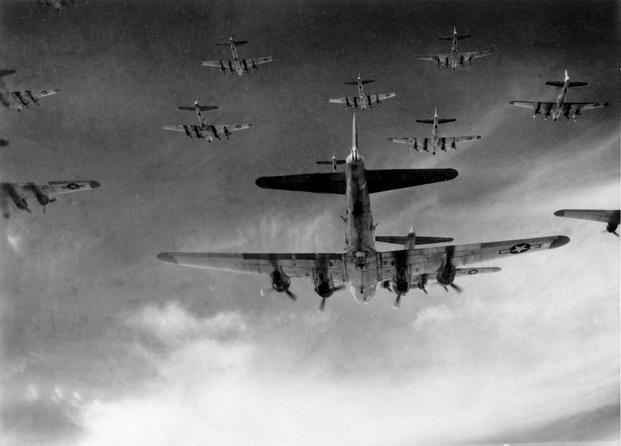Absorbing multiple hits from enemy Luftwaffe planes, maneuvering to avoid dangerous Nazi ground weapons and attacking German targets with .50-cal guns, hundreds of United States Army Air Force's (USAAF) B-17 Flying Fortress bombers launched a massive coordinated assault just prior to the D-Day invasion.
The mission, called Operation Argument, took place on Feb. 20-25, 1944, and was an aggressive Allied bombing attack on German aircraft assembly facilities and factories just months before the D-Day invasion in June 1944. The operation, also called the "Big Week," targeted Nazi targets in Poland, Austria and Germany.
The thinking behind the plan was straightforward: entice Germany's Luftwaffe planes into combat by threatening aircraft production facilities in Germany, and use the opportunity to take out as many fighters as possible, establishing air superiority in advance of the D-Day landings.
"By the time Big Week ended on the 25th, approximately 3,800 sorties by B--17 Flying Fortresses and B--24 Liberators had dropped almost 10,000 tons of munitions, roughly the tonnage dropped by Eighth Air Force during the previous year," Robert Oliver, of the U.S. Air Force Historical Support Division, told Military.com.
Although the damage to factories from the attacks was relatively light, they also resulted in heavy German fighter losses, with U.S. air crews claiming more than 500 German fighters destroyed. Even though that number has been disputed, there is no doubt that Germany lost a large number of planes and pilots that it could not easily replace.
Ultimately, "Big Week" amounted to an early, unofficial start to the air portions of the Normandy invasion, with the positive outcome of Germany spreading its facilities further apart after the attacks.
"The raids caused German industry to disperse, introducing inefficiency and rendering the assembly chain vulnerable to disruptions in transportation," Oliver said.
Big Week Leads to the Big Day
More than 10,000 Allied aircraft supported the D-Day invasion, fortified by the successes of the previous "Big Week" attack.
"USAAF A-20s, B-17s, and B-24s attacked beach defenses and launched raids on choke points behind the landing zones, as well as dropping warning leaflets for the benefit of the French population," Oliver writes.
Known for an ability to bring air crews home alive despite catastrophic battlefield damage, B-17s were cherished by U.S. and British forces as effective, durable weapons. At the same time, the bombers were supported by Allied P-47 and P-51 fighter aircraft that attacked Nazi guns and troop formations while helping Allied ground troops.
Air Force historian Billy Harris also cites the Allied air campaign's activities during the "Big Week" as something that became a decisive factor in the successful D-Day invasion. Harris, a U.S. Air Forces in Europe and Africa historian, wrote that Allies hit German airfields within 350 miles of the beachhead, forcing the Germans to withdraw fighters to protect Germany itself.
"The Allies disrupted aircraft production," Harris said. "More importantly, they inflicted severe losses on the Luftwaffe in air-to-air combat as it tried to defend the factories."
A now-historic USAAF C-47, named "That's All, Brother" as a message to Adolf Hitler, was the transport plane that led the D-Day invasion, according to a report several years ago by Foxtrot Alpha.
"Leading a formation of more than 800 aircraft that dropped 13,000 paratroopers behind enemy lines, it was part of one of the biggest aircraft armadas ever," the report states.
Want to Know More About the Military?
Be sure to get the latest news about the U.S. military, as well as critical info about how to join and all the benefits of service. Subscribe to Military.com and receive customized updates delivered straight to your inbox.















